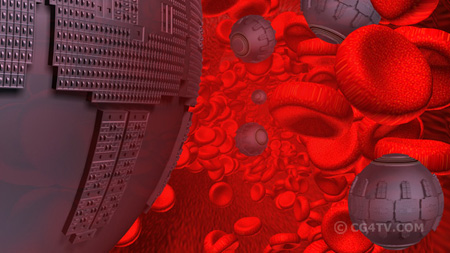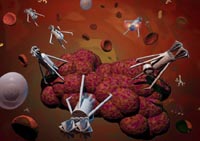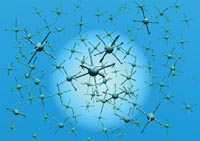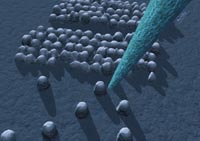|
search
Wednesday, September 19, 2007
DIFFERENT NANO ROBOTS
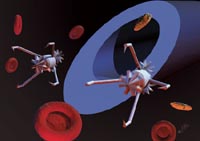 "Driller" nanorobots being injected into an artery through the tip of a needle. |
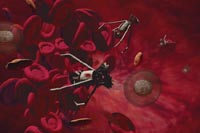 Surgeon nanobot "Drillers" carefully remove a blood clot from an obstructed vein. These robots can operate autonomously or through teleoperation by a surgeon. |
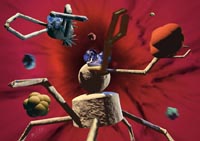 "Driller" nanorobot approaches a sick red blood cell for the final kill. |
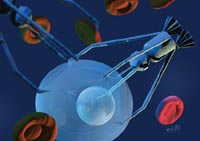 A "Stinger" engages in a delicate surgical operation to remove a cancer tumor. The Stinger nanorobot can inject a toxin or medicine of choice, either autonomously, or through teleoperation. |
History of Nanotechnology
By Chris Phoenix, Director of Research, The Center for Responsible Nanotechnology.
The foundations of nanotechnology have emerged over many decades of research in many different fields. Computer circuits have been getting smaller. Chemicals have been getting more complex. Biochemists have learned more about how to study and control the molecular basis of organisms. Mechanical engineering has been getting more precise.
In 1959, the great physicist Richard Feynman suggested that it should be possible to build machines small enough to manufacture objects with atomic precision. His talk, "There's Plenty of Room at the Bottom," is widely considered to be the foreshadowing of nanotechnology. Among other things, he predicted that information could be stored with amazing density.
In the late 1970's, Eric Drexler began to invent what would become molecular manufacturing. He quickly realized that molecular machines could control the chemical manufacture of complex products, including additional manufacturing systems-which would be a very powerful technology. Drexler published scientific papers beginning in 1981. In 1986 he introduced the term "nanotechnology" in his book Engines of Creation to describe this approach to manufacturing and some of its consequences. (Subsequent search showed that Taniguchi had previously used the word "nano-technology" in Japan to describe precision micromachining.) In 1992 Drexler published Nanosystems, a technical work outlining a way to manufacture extremely high-performance machines out of molecular carbon lattice ("diamondoid"). Meanwhile, he was also engaging in policy activism to raise awareness of the implications of the technology; he founded the Foresight Institute in 1986.
Engines of Creation created much excitement. The term "nanotechnology" rapidly became popular, and almost immediately its meaning began to shift. By 1992, Drexler was using "molecular nanotechnology" or "molecular manufacturing" to distinguish his manufacturing ideas from the simpler product-focused research that was borrowing the word. This research, producing shorter-term results, came to define the field for many observers, and has continued to claim the term "nanotechnology." To avoid confusion, this Press Kit refers to such research as "nanoscale technology."
Federal funding for nanotechnology began under President Clinton with the National Nanotechnology Initiative (NNI). Opinions differ about whether Clinton was influenced by Drexler's descriptions of advanced manufacturing. Instead of focusing on molecular manufacturing, the NNI chose to fund nanoscale technology, which it defined as anything with a size between 1 and 100 nanometers with novel properties. This broad definition encompassed cutting-edge semiconductor research, several developing families of chemistry, and advances in materials.
Meanwhile, a brief mention in Engines of Creation of the dangers of self-replicating systems was proving increasingly troublesome to the field of molecular manufacturing. The idea arose that any molecular manufacturing system would be only one "oops" away from eating the biosphere. The Wired article "Why the Future Doesn't Need Us" by noted computer scientist Bill Joy publicized this concern. Nanoscale technology researchers, fearing-perhaps with justification-that "gray goo" would threaten their funding, increased their efforts to distance their work from molecular manufacturing. One of the easiest ways to do this was to claim that molecular manufacturing was impossible and unscientific. These claims gained force since molecular manufacturing research was (and remains) highly technical, interdisciplinary, theoretical, and mostly undemonstrated.
The controversy continues. Some scientists continue to assert that molecular manufacturing is impossible. Others note that opposition is based on the widespread misinterpretation and misrepresentation of Drexler's work, and that there is no research demonstrating the supposed unfeasibility of molecular manufacturing theory. A published debate between Drexler and Nobelist chemist Richard Smalley in December 2003 illustrated the tone of the controversy, with Smalley accusing Drexler of "hav[ing] scared our children" with "such monster[s] as the self-replicating mechanical nanobot" and Drexler accusing Smalley of having "attempted to dismiss my work in this field by misrepresenting it." The two did not communicate effectively. On the technical side, Drexler mostly restated what he had been saying for years, but Smalley made some interesting scientific errors . A recent paper by Chris Phoenix and Eric Drexler, " Safe Exponential Manufacturing ," is an attempt to distance molecular manufacturing from fears of runaway self-replication.
WELCOME
WELCOME TO THE NEW BLOG
FOR ALL THE MECHANICAL ENGINEERS
HERE U CAN ASK US WHAT U WANT,U LIKE,U HAD
THIS BLOG IS
FOR U
BY U
TO U


